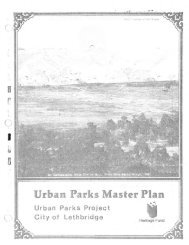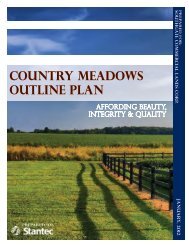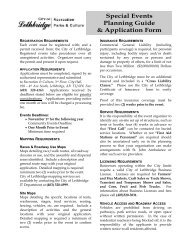Coulees Cottonwoods - City of Lethbridge
Coulees Cottonwoods - City of Lethbridge
Coulees Cottonwoods - City of Lethbridge
Create successful ePaper yourself
Turn your PDF publications into a flip-book with our unique Google optimized e-Paper software.
But the arrival <strong>of</strong> Europeans also marked the beginning <strong>of</strong> the end <strong>of</strong> a lifestyle<br />
followed for centuries. Before the Native peoples saw their first ‘White Man’, his<br />
diseases had spread across the continent, killing up to 90 per cent <strong>of</strong> the Native<br />
peoples <strong>of</strong> North America.<br />
Along with disease came shifts in populations. The Cree began moving westward<br />
in their quest for furs to trade with the Hudson Bay and Northwest companies.<br />
To the south, American notions <strong>of</strong> manifest destiny resulted in a flood <strong>of</strong> settlers<br />
moving west along the Oregon and other trails. In the process, the US government<br />
hired buffalo hunters, who began the systematic slaughter <strong>of</strong> the bison herds in an<br />
effort to destroy the culture <strong>of</strong> the region’s Native inhabitants.<br />
Disease, population shifts, and cultural upheavals created tensions on the prairies<br />
never before experienced by the Native peoples. Tensions led to conflicts – not<br />
only between Natives and the new settlers, but also among Native groups.<br />
Indian Battle<br />
The last inter-tribal conflict in North America occurred in 1870 between the<br />
Blackfoot and the Cree in an area extending from near the original site <strong>of</strong> Fort<br />
Whoop-Up, past the present location <strong>of</strong> the University <strong>of</strong> <strong>Lethbridge</strong>, into the area<br />
now called Indian Battle Coulee and across the river to Indian Battle Park. The<br />
battle was won by the Blackfoot, who gave the name Asinaawa-iitomottaawa, or<br />
“Where We Slaughtered the Crees”, to the general locality.<br />
This battle also marked the end <strong>of</strong> a culture that had existed for over 9,000 years.<br />
Drying hides, tipis, and Native ceremonies were replaced with Europeans seeking<br />
new resources, economic expansion and wealth.<br />
Coal Mining<br />
In 1874, an American Civil War veteran, Nicholas Sheran, came to the area and<br />
began operating a ferry, and mining coal from the surrounding coulees. What the<br />
Blackfoot called Sil-ooh-kotok, or “Black Rocks”, became known by the miners as<br />
“The Coal Banks”.<br />
In 1879, Elliott Galt, assistant to the Commissioner <strong>of</strong> Indian Affairs, noted Sheran’s<br />
coal mine. Galt and his father, Sir Alexander Galt, knew that a railway would soon<br />
be built to join the eastern provinces with British Columbia. Coal would be required<br />
for trains, and for the settlers who were bound to follow the tracks. A decision by<br />
the Canadian Pacific Railway (CPR) to build across the southern prairies gave the<br />
Galts their chance. Sir Alexander organized the North Western Coal and Navigation<br />
Company Limited and hired William Stafford <strong>of</strong> Westville, Nova Scotia, as his first<br />
Superintendent. In 1882, Stafford opened Drift Mines No. 1 and 2, and Coal Lease<br />
No. 4, just under the east end <strong>of</strong> the present High Level Bridge. The hamlet <strong>of</strong><br />
Coalbanks, the precursor to <strong>Lethbridge</strong>, sprang up near the mine entrances where<br />
today the Coalbanks Kiosk, a small interpretive display close to the Helen Schuler<br />
Nature Centre, recognizes the role <strong>of</strong> coal in the development <strong>of</strong> <strong>Lethbridge</strong>.<br />
4











